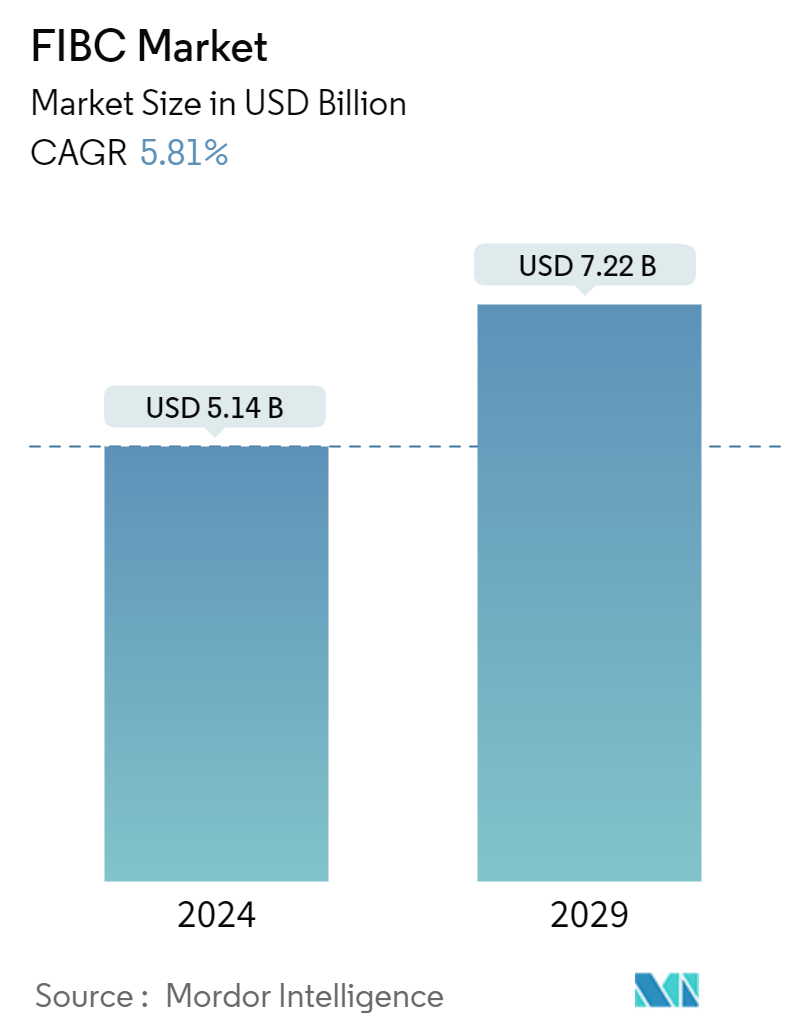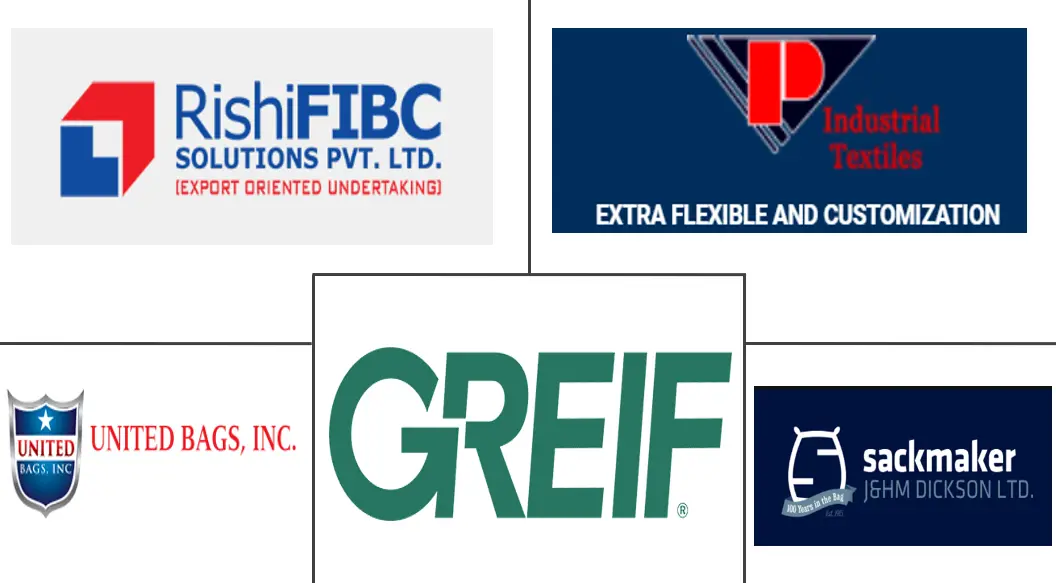Market Size of FIBC Industry

| Study Period | 2019 - 2029 |
| Market Size (2024) | USD 5.14 Billion |
| Market Size (2029) | USD 7.22 Billion |
| CAGR (2024 - 2029) | 5.81 % |
| Fastest Growing Market | Asia Pacific |
| Market Concentration | Low |
Major Players
*Disclaimer: Major Players sorted in no particular order |
FIBC Market Analysis
The FIBC Market size is estimated at USD 5.14 billion in 2024, and is expected to reach USD 7.22 billion by 2029, growing at a CAGR of 5.81% during the forecast period (2024-2029).
- FIBCs are one of the fastest-growing packaging solutions in the industry. One of the main reasons for the FIBC market growth is the fast-paced industrialization in the world. Industries in the chemical industry and agriculture increasingly depend on FIBCs to transport various products, such as grain, rice, potatoes, cereals, and liquid chemicals. FIBCs also play an important role in storing and transporting construction materials, including carbon black, steel, alloys, minerals, cement, and sand.
- Automation and robotics have made a huge impact in many industries. Automation is just beginning to take hold in FIBC manufacturing. Automated production and filling processes for high-quality bulk bags are expected to be a big part of the future of FIBC marketing. In August 2023, Spiroflow, a key Automated Handling Solutions (AHS) company, introduced a next-generation twin-line bulk bag filling system. The auto-release hook and roller conveyor combine to simplify the filling process. Full bulk bags are transferred from the filler onto the conveyors smoothly and automatically. Also, automation reduces the amount of manual intervention.
- As environmental concerns increase, sustainability is now a top priority for businesses and consumers. FIBC producers and marketers are responding to the increasing demand for sustainable packaging solutions. For instance, in January 2024, Vaal Bulk Bags, a producer and supplier of cost-effective bulk bags, unveiled its focus on commitments to innovative packaging solutions with sustainability as the top priority. By focusing on environmental sustainability, the company's goal is to reduce the environmental impact of bulk packaging while preserving the quality and functionality of the products.
- Polyethylene (PE) and polypropylene (PPE) are two of the main raw materials used in most FIBCs and liners worldwide. However, raw material availability has been the most concerning issue both during and post-pandemic periods. Therefore, with disruptive market conditions (high demand, low supply), the FIBC industry witnessed a price rise. FIBC prices have witnessed significant price increases in the past few years that are being passed onto consumers.
- Further, the growth of varied industries involved in international trade is escalating the demand for FIBC or flexible bulk bags. According to the United Nations Conference on Trade and Development's (UNCTAD) most recent Global Trade Update, released on 21 June 2023, after a decline in the latter half of 2022, global merchandise trade bounced back in terms of both volume and value in early 2023. Such a rise in international trade is expected to bolster the demand for FIBC to transport goods across the world.
FIBC Industry Segmentation
The study on the flexible intermediate bulk container market offers an up-to-date analysis of the current regional market scenario, the latest trends and drivers, and the overall market environment. The study tracks the revenue generated from the consumption and sales of flexible intermediate bulk containers offered by the vendors operating in the market.
The FIBC Market is Segmented by type (type A, type B, type C, and type D), design type (U-panel bags, baffle bags, circular bags, 4-side panel bags, and other design types), end user (food and agricultural products, chemical and petrochemical, pharmaceutical, and other end users), and Geography (North America ( United States and Canada), Europe ( United Kingdom, Italy, Germany, France, and Rest of Europe), Asia-Pacific ( China, India, Japan, Australia and New Zealand, and Rest of Asia-Pacific), Latin America, and Middle East and Africa). The market sizes and forecasts are provided in terms of value (USD) for all the above segments.
| By Type | |
| Type A | |
| Type B | |
| Type C | |
| Type D |
| By Design Type | |
| U-Panel Bags | |
| Baffle Bags | |
| Circular Bags | |
| 4-Side Panel Bags | |
| Other Design Types |
| By End-user Industry | |
| Food and Agricultural Products | |
| Chemical and Petrochemical | |
| Pharmaceutical | |
| Other End-user Industries |
| By Geography*** | ||||||
| ||||||
| ||||||
| ||||||
| Latin America | ||||||
| Middle East and Africa |
FIBC Market Size Summary
The Flexible Intermediate Bulk Container (FIBC) market is experiencing significant growth, driven by rapid industrialization and increasing demand from various sectors such as chemicals, agriculture, and construction. FIBCs are becoming essential for transporting and storing a wide range of products, including grains, chemicals, and construction materials, due to their high strength and chemical resistance. The market is also benefiting from advancements in automation and robotics, which are streamlining the manufacturing and filling processes of these bulk bags. Additionally, the rising focus on sustainability is prompting FIBC producers to innovate and offer eco-friendly packaging solutions, addressing environmental concerns while maintaining product quality and functionality.
The market is characterized by a fragmented landscape with numerous players striving to enhance their offerings and expand their global presence. Key regions such as Asia-Pacific, particularly China and India, are expected to contribute significantly to market growth due to their robust export activities and increasing demand for customized bulk packaging solutions. The availability of raw materials like polyethylene and polypropylene remains a critical factor, with recent disruptions leading to price increases. However, the market is poised for expansion, supported by the recovery of global trade and the growing need for efficient packaging solutions in international markets. Prominent companies are actively engaging in collaborations and acquisitions to strengthen their market positions and meet the evolving demands of various industries.
FIBC Market Size - Table of Contents
-
1. MARKET INSIGHTS
-
1.1 Market Overview
-
1.2 Industry Value Chain Analysis
-
1.3 Industry Attractiveness - Porter's Five Forces Analysis
-
1.3.1 Bargaining Power of Suppliers
-
1.3.2 Bargaining Power of Buyers/Consumers
-
1.3.3 Threat of New Entrants
-
1.3.4 Threat of Substitute Products
-
1.3.5 Intensity of Competitive Rivalry
-
-
-
2. MARKET SEGMENTATION
-
2.1 By Type
-
2.1.1 Type A
-
2.1.2 Type B
-
2.1.3 Type C
-
2.1.4 Type D
-
-
2.2 By Design Type
-
2.2.1 U-Panel Bags
-
2.2.2 Baffle Bags
-
2.2.3 Circular Bags
-
2.2.4 4-Side Panel Bags
-
2.2.5 Other Design Types
-
-
2.3 By End-user Industry
-
2.3.1 Food and Agricultural Products
-
2.3.2 Chemical and Petrochemical
-
2.3.3 Pharmaceutical
-
2.3.4 Other End-user Industries
-
-
2.4 By Geography***
-
2.4.1 North America
-
2.4.1.1 United States
-
2.4.1.2 Canada
-
-
2.4.2 Europe
-
2.4.2.1 United Kingdom
-
2.4.2.2 Germany
-
2.4.2.3 France
-
2.4.2.4 Italy
-
-
2.4.3 Asia
-
2.4.3.1 China
-
2.4.3.2 India
-
2.4.3.3 Japan
-
2.4.3.4 Australia and New Zealand
-
-
2.4.4 Latin America
-
2.4.5 Middle East and Africa
-
-
FIBC Market Size FAQs
How big is the FIBC Market?
The FIBC Market size is expected to reach USD 5.14 billion in 2024 and grow at a CAGR of 5.81% to reach USD 7.22 billion by 2029.
What is the current FIBC Market size?
In 2024, the FIBC Market size is expected to reach USD 5.14 billion.

